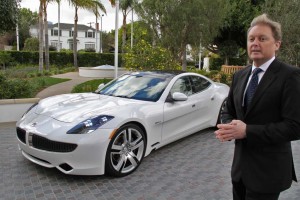TheDetroitBureau.com will offer the first full review of the new Fisker Karma on Wednesday. Make sure to come back.
Though California battery-car start-up Fisker Automotive continues to struggle to come up with a plan that will satisfy the Department of Energy and help it regain access to a promised, low-interest $528 million loan, Fisker’s founder said he is “confident” the company can move ahead even if it means tapping into the private equity market.
Earlier this month, Fisker revealed it would idle more than 65 workers at its suburban Los Angeles headquarters and Delaware assembly plant due to delays in the negotiations with the DoE. But the maker countered reports that said it was halting production of its first plug-in hybrid model, the Fisker Karma.
If anything, production is now ramping up, said the maker’s founder, Henrik Fisker, during a series of conversations that accompanied the first full media drive of the 4-seat Karma sports car. But while the Karma was designed to get Fisker Automotive noticed, the bigger challenge will be to bring the maker’s next product, codenamed Project Nina, to market. And that is going to require significant infusions of cash, he cautioned.
The problem is that to get the DoE loan Fisker Automotive set down what CEO Fisker describes as “aggressive” targets, perhaps “too aggressive,” he quickly corrected himself. “When we set out designing and developing this car,” he later added, “we had to make some estimated and we wound up missing some of those timelines.”
Nonetheless, he stressed, the Karma “is done and out there and, the Danish-born designer stressed, “It’s the first car to actually come to market using money from the DoE loan program.”
Fisker estimated that the firm has so far built about 1,500 of the plug-in hybrids at a plant in Finland and actually taken delivery of more than 400. He didn’t have a precise number for actual sales but suggested the pace is quickening, as is production by Valmet, an independent producer of specialty vehicles. Output is now around 25 of the sports car daily.
“And that may change next week because we’re ramping up every day,” he boasted.
Albeit more lavish and sporty, the Karma has more in common with the Chevrolet Volt “extended-range electric vehicle” than the Nissan Leaf or the Model S being developed by Tesla Motors, another California battery-car start-up. Fisker’s offering relies on a 20 kilowatt-hour battery pack to deliver around 30 miles range on electric propulsion alone. After that, a small gas engine fires up. But it serves solely as a generator to provide additional electric power to two motors driving the rear wheels.
That and its striking shape – the car bears more than a passing resemblance to the Aston Martin DB9 Fisker penned during a previous life as that British marque’s chief designer – have earned the Karma far more interest than its sales numbers might suggest, drawing big-name buyers like actor Leonardo DiCaprio and former Secretary of State Colin Powell.
But even if Karma sales exceed the original estimates that won’t be enough to take the company to the next level, company officials admit. There they need that cash infusion. Preliminary development of the next car — a more mainstream plug-in hybrid expected to cost half that of the $102,000 Karma – is already well underway. But Fisker still needs money to finalize development and tool up the Delaware factory, a former General Motors assembly plant.
The good news, said Henrik Fisker, is that while the DoE loan process has been stalled private equity is coming through. In fact, he noted that the California company has not tapped into the federal till since last May, using other sources of funding since then.
Fisker Automotive raised $260 million during just the final months of 2011 and, during a private conversation with TheDetroitBureau.com, the CEO said he believes that with the U.S. economy rebounding private equity should become even easier to access.
That said, Fisker was anything but boastful about the alternatives, stressing that while “every good manager needs to have a Plan B…we would like to continue working together with the Department of Energy.” If nothing else, it provides a lower cost, lower risk form of funding.
Despite the recent layoffs, it appears that Fisker will continue to work on the development of the Project Nina program, albeit at a slower pace. But there is no question the firm hopes to get the DoE loan snag resolved as soon as possible.

